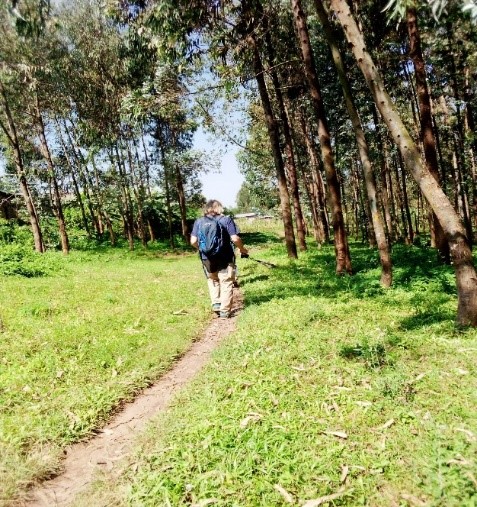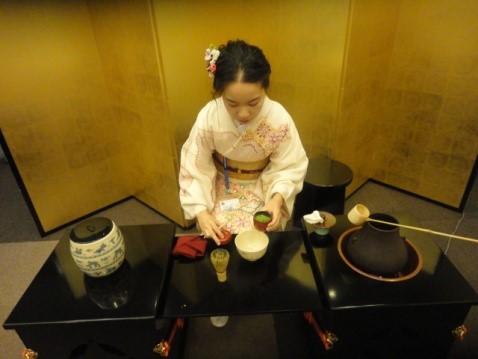The ITP Network Share Heritage and Cultures for World Heritage Day
Each year, the 18th April is celebrated as International Day for Monuments and Sites, also known as World Heritage Day.
The theme for World Heritage Day 2020 is Shared Cultures, Shared Heritage, Shared Responsibility. This theme, which explores ideas of global unity, has become more important in the face of an ongoing worldwide health crisis.
To mark this day, members of the ITP network have shared museum objects or heritage sites that are connected with and valued by multiple groups and communities.
Ancient Gobarau Minaret
Written by Dikko Idris, Chief Curator, National Commission For Museums and Monuments, National Museum, Nigeria (ITP 2011)
The structure popularly known as Gobarau is a fifteen metre minaret located at the heart of Katsina City, Northern Nigeria. An imposing ancient structure, it is one of the largest mud-brick buildings in existence. It is a historical building constructed in the 15th century during the reign of Sarki (King) Muhammadu Korau (AD 1445-1495) believed to be the first Muslim King of Katsina. It was part of the Mosque built by the King. It is also one of the famous landmarks as a surviving example of Islamic architecture in a city known as a theological centre; the tower has become the symbol of the city.

The Minaret is also believed to be the first multi-storey building in West-Africa and was once the tallest building in Katsina. It was built with traditional building materials which includes conical brick, clay, laterite, corn stuck, and Raffia rope depicting Hausa traditional mud architecture.
Nyanza Cultural Trails: Walking the history and nature in Nyanza District, southern province of Rwanda
Written by Chantal Umuhoza, Curator, Institute of National Museums of Rwanda (INMR) (ITP 2018)
Hiking experiences in Rwanda have taken off, with a unique set of two premium certified cultural trails from which hiking and walking enthusiasts in Rwanda get more high-quality options to choose from. Home to the Kings’ Palace Museum and Kwigira Museum-Rwesero, Nyanza District is also the home to these internationally recognised trails, certified premium by the President of the German Hiking Institute.
The two cultural trails (Royal & Big View) are circular in nature and the first of their kind in Rwanda. They offer hikers innovative quality experiences that help them gain a deeper sense of rural life through nature walks that connect different cultural and natural landmarks.

Visitors experience authentic Rwandan town, village and country life with different houses, agriculture and livestock. The flagship Royal Trail links important cultural sites relating to Nyanza’s history in a pleasant 10km trek.
Visitors experience the ‘Jordan of Nyanza’ at Icyuzi cya Nyamagana, Kwigira Museum-Rwesero, the Kings’ Palace Museum, Mwima Mausoleum, Christ the King church built by Belgians in 1935, Mu Gakeneyeri kwa Musinga (Former Royal residence), and Rwanda African Art Museum among other delights.

The Royal trail takes hikers through the cultural history, natural landscapes and ambience with stunning viewpoints. The other Trail, Big View, is an 8km long trail that leads to Remera hill from Nyanza town and extends the experience of the premium trails in Nyanza with impressive 360-degree views from the hill over the surrounding countryside for more than 50km.
The two trails connect hikers to another stop-over at one of the CBTE’s (Community Based Tourism Enterprises), where hikers get farming experience and taste fresh fruits as they walk around the community farm.

Nyanza District being the former Royal Capital from Rwanda’s pre-colonial past, for both visitors and locals, the history of Rwanda’s monarchy is fascinating and important to learn more about.
The Royal Trail and Big View Trail were launched and opened to the public on December 4th, 2019, with over 200 dignitaries, tourism experts, and culture enthusiasts participating in the first hike. The initiative and development of these trails is part of a wider project towards the diversification and promotion of tourism, especially focusing on the rich cultural resources along the Southern Heritage Corridor stretching from Kigali across eight Districts in the Southern Province.
Shared cultural spaces in Iran
Ala Talebian, Tehran University, Iran, (ITP 2017)

This year, on the occasion of the International Day for Monuments and Sites, ICOMOS proposed the theme of Shared Cultures, Shared Heritage, Shared Responsibility. The idea of shared cultures and the acceptance of the validity of multiple narratives becomes increasingly important today as the ongoing worldwide health crisis reminded us that we are in this all together and we are deeply interconnected as a global community. For this purpose, I would like to attract attention to two sites in Iran. The Tomb of Daniel, located in Susa, and Ciye Tir Street in the hearth of the capital, Tehran.
Starting the with the Tomb of Daniel, it is the traditional burial place of the biblical prophet, Daniel. He, in 586 BC as a Jewish youth, was taken into captivity by Nebuchadnezzar of Babylon. Later, when Cyrus conquered Babylon, Daniel moved to Persia and settled in the city of Susa, where he later gained power and respect which he maintained until the end of his life. Various locations have been named for the place of his tomb, but the tomb in Susa, is the most widely accepted. It being first mentioned by the Jewish traveller Benjamin of Tudela: “In front of one the synagogues is the sepulchre of Daniel of blessed memory…”

Daniel is described as a prominent Jew, who had good virtues and deeds. In addition, various branches of the Christian church recognise him as the Prophet, and although he has not been mentioned in the Quran, Muslims refer to him as a prophet as well. It is also believed that when Muslims entered Susa and they found out about his burial place, Ali ibn Abi Talib, the cousin and son-in-law of the Islamic prophet Muhammad, cited: “whoever visits my brother, Daniel’s tomb, is as he visited mine”
Therefore, the Tomb of Daniel is a testament to religious diversity in Iran, and has been a place of shared Jewish and Muslim pilgrimage. Muslims as well as Jews consider Daniel holy, have belief in him and regularly visit and do their prayers there. Furthermore, The Tomb of Daniel’s architecture, which is known for its stepped-conical white dome that rests on an octagonal base, later influenced the architecture of mosques’ dome in its region, Khuzestan.

The second site, is placed in the centre of Tehran and has a very unique quality. It has brought four different religions together. Ciye Tir Street can be considered as one of the oldest and most original streets, which holds some of the ‘firsts’ in the history of Tehran and even Iran. The coexistence of cultures and religions due to the existence of a mosque, church, synagogue and fire temple can be clearly seen on this street.
Adrian Fire Temple and Firooz Bahram High School
This fire temple was built about 90 years ago and brought its fire from the city of Yazd. Furthermore, its architecture is inspired by Persepolis. Next to the fire temple is the Firooz Bahram High School, one of the most famous Zoroastrian educational centres.
Hazrat Ebrahim Mosque
Located next to the Abgineh Museum, Hazrat Ebrahim Mosque is the place of worship for Muslims of the area.
Haim Synagogue
Haim Synagogue is known as the first urban synagogue in the history of Iran and dates back to 100 years ago. Earlier, Jews were only allowed to build synagogues inside Jewish sectors of the city.

Saint Peter’s Church
The St. Peter Church was built in 1891 by Protestant missionaries. After this, Christians settled near the church and in its surroundings.
Saint Mary Church
In addition to St. Peter Church, Ciye Tie street is the home for another church as well. Surp Asdvadzadzin Church, or Saint Mary Church is an Armenian Apostolic church in Tehran, completed in 1945.
Both of these sites bring national pride to each of the region’s people and shows us that these communities transcend social, economic and political boundaries and are able to live peacefully next to each other as humans. A lesson we all need to learn and reconsider especially during the time of this global pandemic.
Similarities in culture between Iran and Japan
Written by Khadijeh Zohreh Baseri, Officer, Golestan Palace, Iran (ITP 2007)
We live in a world that is interconnected. Maybe we are far from each other, but with cultural heritage we are connected to each other. Perhaps the geography of the land belongs to me, but cultural heritage of my land belongs to the whole world. And this is a world heritage, so we are all responsible for it. This world heritage must be preserved because destruction and looting of cultural property has emotional, psychological and economic effects.
We are losing the past, so we must get to know the global sites and look after them. All cultural property has stories from the past. They are far apart and very similar. I’m here with pictures I took of Japan and also from Iran. Cultural commonalities between nations and countries will show you no matter where we live, cultures, ceremonies and celebrations are very similar. With all the similarities and differences, then importance and responsibility in maintaining this cultural property is shared by all people.
In Iran and Japan and all countries there are mosques, temples and religious and sacred places. There are also many traditional and religious celebrations and ceremonies. Are all these traditions a common cultural heritage and heritage? Imamzadeh in Iran, which is a place of pilgrimage for the people, a number of women are engaged in worship. A religious building in Japan as well as many others people have come to visit.



Local markets for fruits, food and handicrafts for sale.
The traditional Yalda ceremony, which took place in a traditional house. There are also traditional tea ceremonies in Japan.


While in other countries like Greece, Turkey, Cyprus, Italy are very similar there are other buildings as well like museums that have a lot of objects and treasures. They are similar to each other, which I will definitely show in the future.
Lotoan
Written by Aprille P Tijam, Senior Manager, Exhibitions and Collections, Ayala Museum, Philippines (ITP 2019)

Ayala Museum Collection
Betel nut chewing has been practiced in the Philippines since pre-Colonial times. It is valued for the simple pleasure that it offers or may be associated with rituals. It is a shared practice by different Philippine indigenous groups and has nurtured relationships. Village members gather to enjoy betel nut chewing together.
The preparation for betel nut chewing is a ritual by itself. A bit of apog or lime from roasted and ground oyster shell for calcium is spread on a portion of betel leaf, rolled with a bit of moistened tobacco leaf and areca nut, then chewed. The chewing produces a burning sensation inside the mouth, while excess juices are spit out. This traditional practice gives an intoxicating experience, with a ‘natural high.’
In southern Philippines, lotoan is the most recognised container for betel nut chewing ingredients, with compartmentalised spaces for areca nut (from areca palm fruit, Areca catechu), betel leaves, dried tobacco, and ground lime. This exceptionally large ceremonial lotoan from the Ayala Museum collection is made of cast bronze and brass with wheels. It has compartments for the ingredients, ashtrays shaped into doves, scissors for cutting nuts, mortar-and-pestle to grind the roasted shell for calcium lime, and spatula. A lotoan is even considered a family heirloom.




